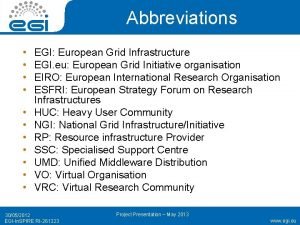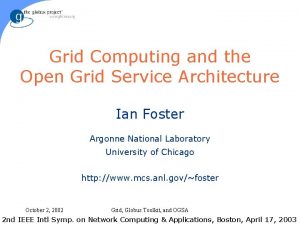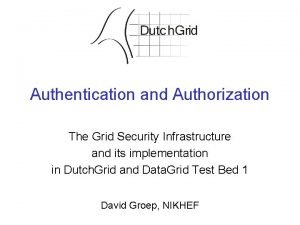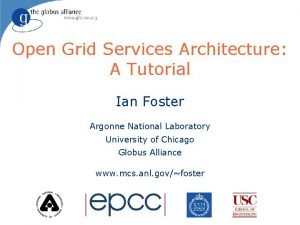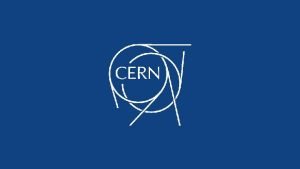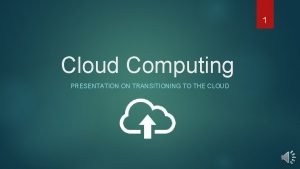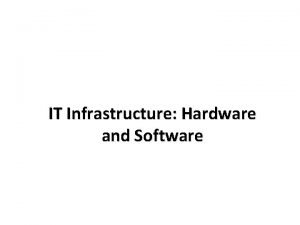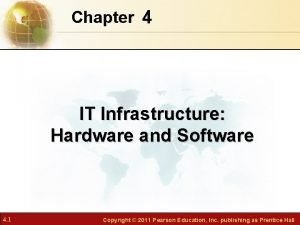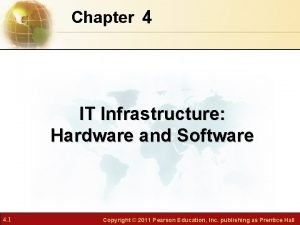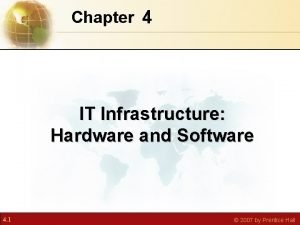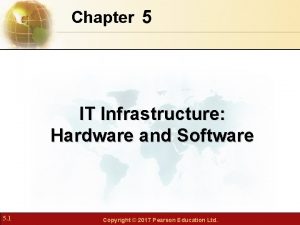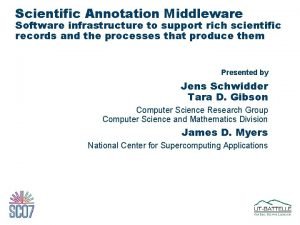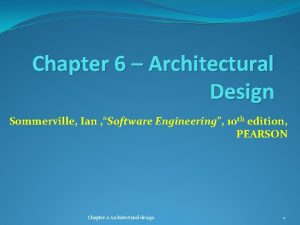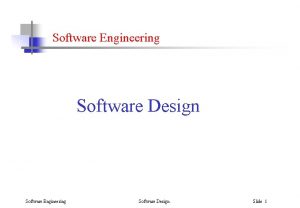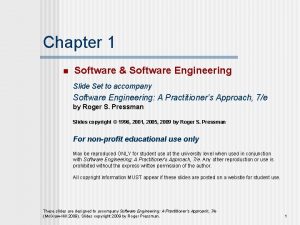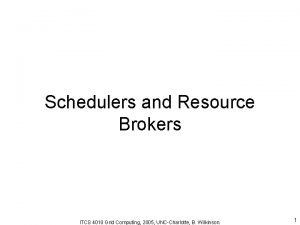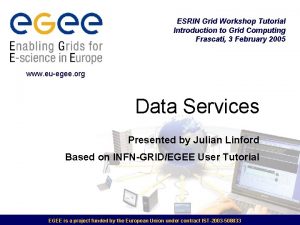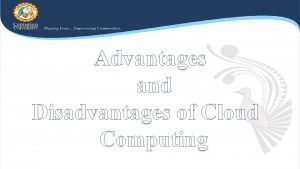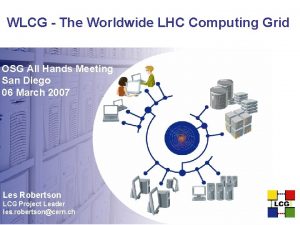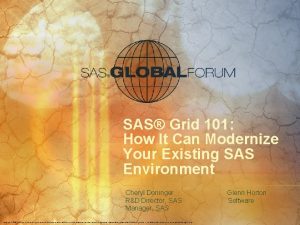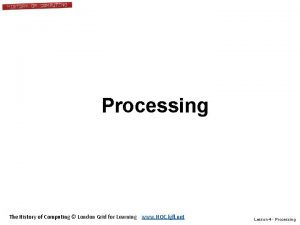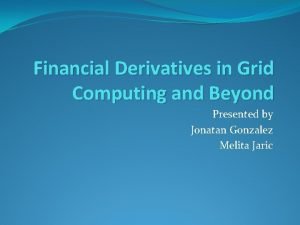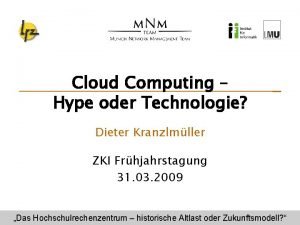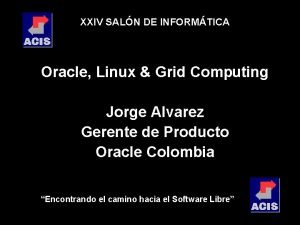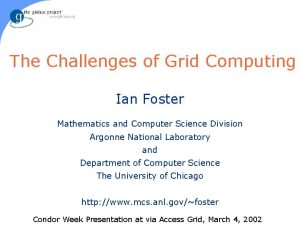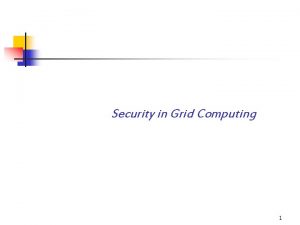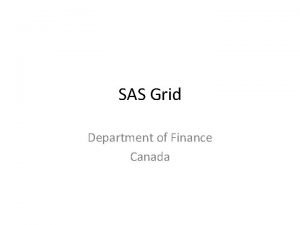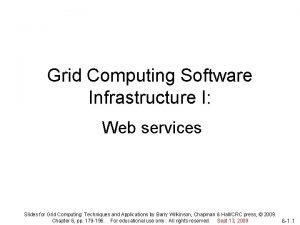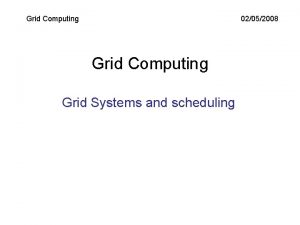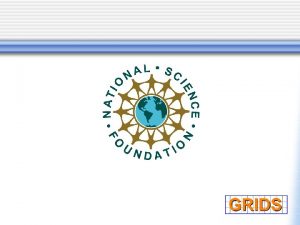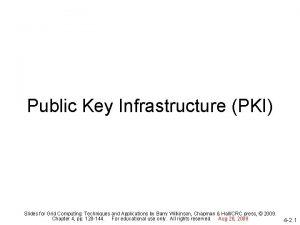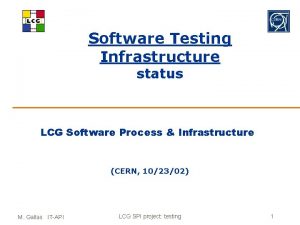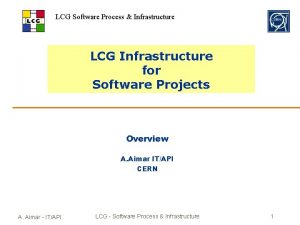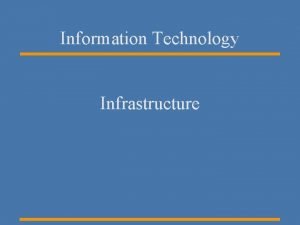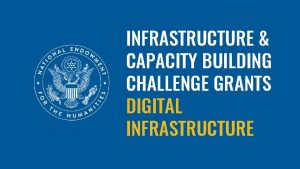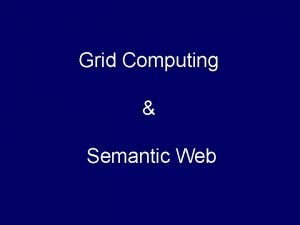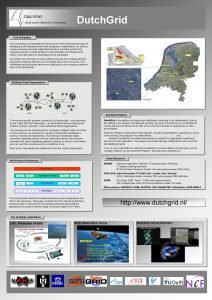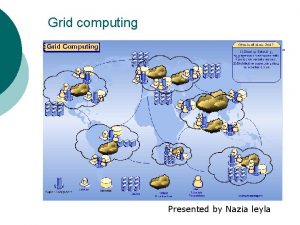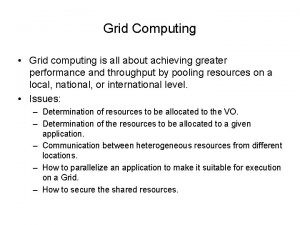Grid Computing Infrastructure Software Slides for Grid Computing






































































![Java client to invoke service public class Client { public static void main(String[] args) Java client to invoke service public class Client { public static void main(String[] args)](https://slidetodoc.com/presentation_image/0c4c06418d52db02fae2f8a3c9653940/image-71.jpg)













- Slides: 84

Grid Computing Infrastructure Software Slides for Grid Computing: Techniques and Applications by Barry Wilkinson, Chapman & Hall/CRC press, © 2009. Chapter 7, pp. 201 -213. For educational use only. All rights reserved. Sept 13, 2009 7 -1. 1

Grid computing software Gone through several development cycles. Started before grid computing standards became accepted. Clearly need standardized protocols and interfaces for wide adoption of grid computing. 7 -1. 2

Standards Bodies Key players for Internet and World Wide Web: • IETF (Internet Engineering Task Force) – Formed in 1985 for Internet standards inc. previous TCP/IP • W 3 C consortium (Worlds Wide Web Consortium) – founded by Tim Berners-Lee shortly after he conceived World Wide Web in early 1990’s – Standardization of Web-related technologies • OASIS (Organization for the Advancement of Structured Information Standards) • Began as SGML Open in 1993 to promote SGML • Became OASIS in 1998 to focus on structured information standards including newly developed XML • DMTF (Distributed Management Task Force) • Created in 1992 for IT systems management infrastructure 7 -1. 3

Organizations for Grid computing • Open Grid Forum (OGF) – Principal Grid computing body – Began as Grid forum in 1998 – Merged with e. Grid (European Grid) forum and Asia. Pacific Grid community to form Global Grid Form (GGF) in 2001 • GGF meets three times a year around world • GGF 1 (March 2001), GGF 2, GGF 3 … – GGF became OGF in 2006 and continued meetings. • GGF 18 became OGF 18 – OGF 24 met in Sept. 2008 in Singapore. – Meetings grown to a very large endeavour today, with participants across world attending. 7 -1. 4

Standards in Web Services World • • XML introduced (ratified) in 1998 SOAP ratified in 2000 Web services introduced 2000 Subsequently, many standards developed: – WSDL – WS-* where * refers to names of one of many standards – Mostly by W 3 C organization 7 -1. 5

Using web services • It would be natural to use web services for grid computing components. • Provides a easily identifiable interface through WDSL documents. • Has Internet addressing (URLs). 7 -1. 6

(Stateless) Web Services” • “Pure” web services are stateless. • They do not remember information from one invocation to the next. • That can work fine for many web service applications. • They do not need to know what happened with a previous invocation by another client. 7 -1. 7

Simple previous Web service example • Web service Math. Service with a method inc to add 1 to the supplied argument and return the result: Fig 7. 1 7 -1. 8

“Stateful” web service example • With a method to add a value to an accumulating value and return its value: Fig 7. 2 7 -1. 9

Stateful Web service as a front-end to a database Fig 7. 3 7 -1. 10

• In this example, the client accesses a service to perform actions such as access a database. • Key aspect here is that the state is contained in a resource that can be separate from the web service. • Web service becomes a front end to the resource. • Come back to this concept later. 7 -1. 11

Open Grid Services Architecture (OGSA) • Originally proposed by Foster et al. in paper: “The Physiology of the Grid” (see reading list) • Anounced as Grid computing standard at GGF 4 in Feb 2002. • Defines standard mechanisms for creating, naming, and discovering service instances. • Addresses architectural issues relating to interoperable services for grid computing. • Does not give details of implementation. • Requires stateful services but does not say how that will be achieved. 7 -1. 12

Open Grid Service Infrastructure (OGSI) • Introduced in 2002 -3 (final draft June 2003). • First attempt to standardize how stateful Web services will be implemented. • Modifies WDSL to enable state to be specified, using a language called GWSDL (“Grid Web Definition Language”), • Introduced term Grid service. • OGSI included inheritance, addressing mechanism, notifications, and message passing mechanism. • Implemented in Globus toolkit version 3 (GT 3). 7 -1. 13

Open Grid Service Infrastructure (OGSI) • Not found acceptable by community at large because: – It significantly modified pure Web service approach – Required new tools – Too object oriented in approach – Too much specified in one standard. It would be better broken down in a series of specifications 7 -1. 14

WS-Resource Framework (WSRF) • Web service community also working on approaches to stateful Web services. • Web and Grid communities merged on WSResource Framework approach. • Specification developed by OASIS in 2004 – Replace OGSI and makes implementation of a stateful Web service acceptable. • Specifies how to make Web service stateful and other feature, without drifting from the original Web services concept. 7 -1. 15

Grid computing standards Figure from “An ‘Ecosystem’ of Grid Components”, 2004, Grid Research Integration Deployment and Support Center, http: //www-unix. gridscenter. org/r 6/ecosystem/ecology. php 7 -1. 16

From “The Globus Toolkit 4 Programmer’s Tutorial” by Borja Sotomayor. 7 -1. 17

Grid service • Broad meaning -- any service that conforms to interface conventions of a Grid computing infrastructure • Narrow (current) meaning -- a service that conforms to WSRF • Term seems to have lost favor – maybe because better to think of services in a Grid environment simply as regular Web services 7 -1. 18

Stateful Web Services • Obtained in WSRF by having a web service front- end to a stateful “resource. ” 7 -1. 19

Web Service Resource Framework (WSRF) Resource Web Service Client Resource properties Holds information retained between accesses. 7 -1. 20

WSDL file with WSRF • Serves same purpose as WSDL file in web services – to define the service interface. • A significant addition in the WSDL file is to specify the resource. 7 -1. 21

Container WSDL file includes specifying resource Resource Web Service Client Resource properties Holds information retained between accesses. 7 -1. 22

“Stateful” web service example revisited • With a method to add a value to an accumulating value: Fig 7. 4 7 -1. 23

Service Interface • If service implements operations on WSRF resource properties, WSDL will include definitions relating to resource property. • Resource Properties declared in WSDL file because it describes how the properties must be exchanged in XML (between clients, services, etc. ) 7 -1. 24

Contents of Math. xml. . . <!-- RESOURCE PROPERTIES --> <xsd: element name="Value" type="xsd: int"/> <xsd: element name="Last. Op" type="xsd: string"/> <xsd: element name="Math. Resource. Properties"> <xsd: complex. Type> <xsd: sequence> <xsd: element ref="tns: Value" min. Occurs="1" max. Occurs="1"/> <xsd: element ref="tns: Last. Op" min. Occurs="1" max. Occurs="1"/> </xsd: sequence> </xsd: complex. Type> </xsd: element>

Client Code Examples Math. Port. Type math = locator. get. Math. Port. Type. Port(endpoint); math. add(10); update. RP(endpoint, Math. Constanst. RP_VALUE, “ 100”); print. Resource. Properties(math);

Client Code Examples value. RP = math. get. Resource. Property( Math. QNames. RP_VALUE); value = value. RP. get_any()[0]. get. Value(); System. out. println("Value RP: " + value);

Resource Properties from the Command Line C: > wsrf-query -s http//localhost/wsrf/ services/examples/core/rp/Math. Service <ns 1: Math. Resource. Properties xmlns: ns 1=”http: //www. globus. org/namespaces/ examples/math. Service_instance_rp”> <ns 1: Value>100</ns 1: Value> <ns 1: Last. Op>ADDITION</ns 1: Last. Op> </ns 1: Math. Resource. Properties>

Resource Properties from the Command Line C: >wsrf-get-property -s http//localhost/wsrf/services/examples/ core/rp/Math. Service {http: //www. globus. org/namespaces/ examples/math. Service_instance_rp}Value <ns 1: Value xmlns: ns 1=”http. . . ”>100</ns 1: Value>

Other key issues Addressing • WSRF service needs an addressing mechanism that includes access to the resource • Pure web services typically use URIs (URLs) • WSRF service addressing defined in WSaddressing standard – Uses an “endpoint reference” 7 -1. 30

Endpoint Reference EPR Includes both: – Service address (URI) and – Resource identification (called a “key”) 7 -1. 31

Endpoint Reference (EPR) • Service URI + resource identifier (key) Fig 7. 5 7 -1. 32

EPR - Web service without an associated resource <wsa: Endpoint. Reference> <wsa: Address> http: //www. cs. uncc. edu/my. Web. Service. jws </wsa: Address> </wsa: Endpoint. Reference> where <Address> tag is required. prefix wsa is WS-Addressing namepace (http: //www. w 3. org/2005/08/addressing/wsdl) 7 -1. 33

EPR - Web service with an associated resource <wsa: Endpoint. Reference> <wsa: Address> http: //www. cs. uncc. edu/my. Web. Service. jws </wsa: Address> <wsa: Reference. Parameters> <myrp: ID> 234 </myrp: ID> </wsa: Reference. Parameters> </wsa: Endpoint. Reference> Resource ID specified within <Reference. Parameters>. Not specified within WSDL document itself. Separated out and obtained when EPR obtained 7 -1. 34

WS-Addressing Terms Endpoint – the destination where the web service can be accessed. Endpoint reference (EPR) – describes destination: includes destination location as URI, but can have other parameters like a key 7 -2. 35

Endpoint reference, EPR Like all WS-* specs, defined in terms of XML. Defined as complex type. Can contain: • Address (a URI) (required) • Reference Properties • Reference Parameters • Port type • Service name • Policy elements Corresponds to port. Type and service of WSDL document 7 -2. 36

SOAP message WS-Addressing standard requires that contents of: <wsa: Address> and <wsa: Reference. Properties> must appear in SOAP’s header: <soap: Envelop> <soap: Header>. . . <wsa: To>http: //www. cs. uncc. edu/axis/abw/Myservice. jws</wsa: To> <resource. ID>234</resource. ID>. . . </soap: Header> <soap: Body>. . . </soap: Body> </soap: Envelop> 7 -2. 37

WSRF Framework • Actually collection of four specifications: – WS-Resource. Properties • Specifies how resource properties are defined and accessed – WS-Resource. Lifetime • Specifies mechanisms to manage resource lifetimes – WS-Service. Group • Specifies how to group services or WSResources together – WS-Base. Faults • Specifies how to report faults 7 -1. 38

WS-* Standards continued Also: • WS-Notification – Collection of specifications that specifies how configure services as notification producers or consumers • WS-Addressing (where EPR is defined) – Specifies how to address web services. – Provides a way to address a web service/resource pair 7 -1. 39

Concrete example Globus 4. 0 Web Service Assignment This assignment is based upon a GT 4 service described by Sotomayor and Childers (2006). (Textbook describes a generic GT 4 service. ) 7 -1. 40

Assignment Goals • Show stateful WSRF Web services can be created and deployed in Globus 4. 0. • Assignment is to be done on your own computer (or a lab computer). • Requires you to install Globus 4. 0 core and associated software – all available for download. 7 -1. 41

Installing software Will need to have or install: • • JDK 1. 4. 2+ Ant 1. 5. 1+ Python 2. 4+ Globus ws-core-4. 0. + and set environment variables (paths) accordingly as explained in assignment write-up. Enjoy! 7 -1. 42

Testing installation Start Container Command: globus-start-container -nosec specifies “no security”, which simplifies assignment (no need for user certificates) Will show list of deployed services. 7 -1. 43

Standard list of deployed services in core Fig 7. 7 7 -1. 44

Purpose of Service To store an integer called value, which can be acted upon by three methods to: • Add argument a to value, and • Subtract argument a from value • Get value These methods given. Further methods will be implemented. Service is stateful (value retained between accesses). 7 -1. 45

Java Interface for service public interface Math { public void add(int a); public void subtract(int a); public int get. Value. RP(); } 7 -1. 46

Resource Properties In code provided, actually two resource properties: • Value -- an integer acted upon by the operations: – add – sub – get. Value. RP • “Last operation performed” -- a string holding name of last operation done, “ADDITION” or “SUBTRACTION”, which is not used in assignment. 7 -1. 47

Resource Properties Resource Math Web Service Client Resource properties “value” (integer) “last operation performed” (string) 7 -1. 48

Steps in Assignment • Preliminary set-up – Install GT 4 and associated software • Download provided files: – – WSDL service interface file Stateful Math web service code (in Java) WSDD Deployment Descriptor file Client code (java) to exercise service • Build Math service – Package all files into an archive file (. gar) • Deploy Math service into GT 4 container • Write and compile the client • Start container and execute client. Easy! 7 -1. 49

Final Step in Assignment • Add functionality to service – Add multiple operation to Math service – Requires you to modify WSDL (by hand), service code, and client code. – For that you will need to understand the files – Assignment Appendix gives details 7 -1. 50

WSDL file • Serves same purpose as WSDL file in Web services – to define the service interface. • A significant addition in the WSDL file is to specify the resource. 7 -1. 51

Globus-specific features of WSDL • Resource properties – specified in port. Type attribute wsrp: Resource. Properties • WSDL preprocessor used to include WSRF definitions (port. Type attribute wsdlpp: extends). • Bindings (how abstract interface maps to concrete protocol messages) – not needed because automatically inserted by GT 4 when built. 7 -1. 52

WSDL file Name of service being implemented <definitions name="Math. Service” target. Namespace=“http: //www. globus. org/namespaces/ examples/core/Math. Service_instance” xmlns="http: //schemas. xmlsoap. org/wsdl/" xmlns: tns=http: //www. globus. org/namespaces/ Namespaces examples/core/Math. Service_instance xmlns: wsdl="http: //schemas. xmlsoap. org/wsdl/" xmlns: wsrp="http: //docs. oasis-open. org/wsrf/2004/06/ wsrf-WS-Resource. Properties-1. 2 -draft-01. xsd" xmlns: wsrpw="http: //docs. oasis-open. org/wsrf/2004/06/ wsrf-WS-Resource. Properties-1. 2 -draft-01. wsdl" xmlns: wsdlpp="http: //www. globus. org/namespaces/2004/10/ WSDLPreprocessor" xmlns: xsd="http: //www. w 3. org/2001/XMLSchema"> <wsdl: import namespace= "http: //docs. oasis-open. org/wsrf/2004/06/ wsrf-WS-Resource. Properties-1. 2 -draft-01. wsdl" location=". . /wsrf/properties/WS-Resource. Properties. wsdl" /> 7 -1. 53

<types> <xsd: schema target. Namespace="http: //www. globus. org/namespaces/ examples/core/Math. Service_instance" xmlns: tns="http: //www. globus. org/namespaces/examples/core/ Math. Service_instance" xmlns: xsd="http: //www. w 3. org/2001/XMLSchema"> add <!-- REQUESTS AND RESPONSES --> method, <xsd: element name="add" type="xsd: int"/> argument <xsd: element name="add. Response"> int, returns <xsd: complex. Type/> a complex </xsd: element> type <xsd: element name="subtract" type="xsd: int"/> <xsd: element name="subtract. Response"> <xsd: complex. Type/> </xsd: element> <xsd: element name="get. Value. RP"> <xsd: complex. Type/> </xsd: element> <xsd: element name="get. Value. RPResponse" type="xsd: int"/> 7 -1. 54

<!-- RESOURCE PROPERTIES --> <xsd: element name="Value" type="xsd: int"/> <xsd: element name="Last. Op“ type="xsd: string"/> <xsd: element name="Math. Resource. Properties"> <xsd: complex. Type> <xsd: sequence> <xsd: element ref="tns: Value“ min. Occurs="1“ max. Occurs="1"/> <xsd: element ref="tns: Last. Op“ min. Occurs="1“ max. Occurs="1"/> </xsd: sequence> </xsd: complex. Type> </xsd: element> </xsd: schema> </types> 7 -1. 55

<!- M E S S A G E S --> Input and <message name="Add. Input. Message"> output <part name="parameters" element="tns: add"/> message for </message> add method <message name="Add. Output. Message"> <part name="parameters" element="tns: add. Response"/> </message> <message name="Subtract. Input. Message"> <part name="parameters" element="tns: subtract"/> </message> <message name="Subtract. Output. Message"> <part name="parameters" element="tns: subtract. Response"/> </message> <message name="Get. Value. RPInput. Message"> <part name="parameters" element="tns: get. Value. RP"/> </message> <message name="Get. Value. RPOutput. Message"> <part name="parameters" element="tns: get. Value. RPResponse"/> </message> 7 -1. 56

<!-- P O R T T Y P E --> <port. Type name="Math. Port. Type" wsdlpp: extends="wsrpw: Get. Resource. Property" wsrp: Resource. Properties="tns: Math. Resource. Properties"> <operation name="add"> <input message="tns: Add. Input. Message"/> <output message="tns: Add. Output. Message"/> </operation> <operation name="subtract"> <input message="tns: Subtract. Input. Message"/> <output message="tns: Subtract. Output. Message"/> </operation> <operation name="get. Value. RP"> <input message="tns: Get. Value. RPInput. Message"/> <output message="tns: Get. Value. RPOutput. Message"/> </operation> </port. Type> </definitions> 7 -1. 57

Service Code The code has two major parts: • Resource properties • Service code (methods) which are combined into one file for this assignment. 7 -1. 58

Service – Resource Properties public class Math. Service implements Resource, Resource. Properties { private Resource. Property. Set prop. Set; /* Resource Property set */ private int value; Resource properties private String last. Op; public Math. Service() throws Remote. Exception { /* RP Constructor */ this. prop. Set = new Simple. Resource. Property. Set( Math. QNames. RESOURCE_PROPERTIES); /* Create RP set */ try { /* Initialize the RP's */ Resource. Property value. RP = new Reflection. Resource. Property( Math. QNames. RP_VALUE, "Value", this); this. prop. Set. add(value. RP); Resource set. Value(0); Property Resource. Property last. Op. RP = new code Reflection. Resource. Property( Math. QNames. RP_LASTOP, "Last. Op", this); this. prop. Set. add(last. Op. RP); set. Last. Op("NONE"); } catch (Exception e) { throw new Runtime. Exception(e. get. Message()); } 7 -1. 59 }

Service – Resource Properties methods /* Get/Setters for the RPs */ public int get. Value() { return value; } public void set. Value(int value) { this. value = value; } public String get. Last. Op() { return last. Op; } public void set. Last. Op(String last. Op) { this. last. Op = last. Op; } 7 -1. 60

Service code - methods. . /* Remotely-accessible operations */ public Add. Response add(int a) throws Remote. Exception { value += a; add last. Op = "ADDITION"; return new Add. Response(); method } public Subtract. Response subtract(int a) throws Remote. Exception { value -= a; last. Op = "SUBTRACTION"; return new Subtract. Response(); } public int get. Value. RP(Get. Value. RP params) throws Remote. Exception { return value; }. . 7 -1. 61

Deploying a GT 4 service • GT 4 container uses Apache Axis • Basic steps for deploying a service similar in concept to that described for Apache Axis. 7 -1. 62

Deployment files • server-config. wsdd (Web Service Deployment Descriptor) - contains information about the web service. • jndi-config. xml (JNDI configuration file) - contains information about the resource management. 7 -1. 63

<? xml version="1. 0" encoding="UTF-8"? > <deployment name="default. Server. Config" xmlns="http: //xml. apache. org/axis/wsdd/" xmlns: java="http: //xml. apache. org/axis/wsdd/providers/java" specifies xmlns: xsd="http: //www. w 3. org/2001/XMLSchema"> where service <service name="examples/core/first/Math. Service" will be provider="Handler" use="literal" style="document"> located. <parameter name="class. Name"value="org. globus. examples. services. core. first. impl. Math. Service"/> <wsdl. File>share/schema/examples/Math. Service_instance/ Math_service. wsdl </wsdl. File> <parameter name="allowed. Methods" value="*"/> <parameter name="handler. Class“ value="org. globus. axis. providers. RPCProvider"/> <parameter name="scope" value="Application"/> <parameter name="providers" value="Get. RPProvider"/> <parameter name="load. On. Startup" value="true"/> </service> 7 -1. 64 </deployment> WSDD file

ant (Another Neat Tool) • A build tool used for building service – forming package of files for deployment – a gar file (grid archive file) • ant similar to make program but dependencies specified using XML configuration files. • Windows version of assignment uses Python. 7 -1. 65

Generating GAR file with Ant From http: //gdp. globus. org/gt 4 tutorial/multiplehtml/ch 03 s 04. html 7 -1. 66

GT 4 build command globus-build-service. sh first where first is a file that contains required bash and ant files. Windows Python version globus-build-service. py first 7 -1. 67

Deploying Service Deployment done using GT 4 command: globus-deploy-gar gar_file using the gar file created by globus-buildservice. 7 -1. 68

Start Container Command: globus-start-container -nosec Math. Service will be listed as one of the services that are available once the container has started. 7 -1. 69

GT 4 container Mathservice 7 -1. 70
![Java client to invoke service public class Client public static void mainString args Java client to invoke service public class Client { public static void main(String[] args)](https://slidetodoc.com/presentation_image/0c4c06418d52db02fae2f8a3c9653940/image-71.jpg)
Java client to invoke service public class Client { public static void main(String[] args) { Math. Service. Addressing. Locator locator = new Math. Service. Addressing. Locator(); try { String service. URI = args[0]; Endpoint. Reference. Type endpoint = new Endpoint. Reference. Type(); endpoint. set. Address(new Address(service. URI)); //service endpt ref. Math. Port. Type math; math = locator. get. Math. Port. Type. Port(endpoint); // Get Port. Type math. add(10); // Perform an addition math. add(5); // Perform another addition System. out. println("Current value: " + math. get. Value. RP(new Get. Value. RP())); // Access value math. subtract(5); // Perform a subtraction System. out. println("Current value: " + math. get. Value. RP(new Get. Value. RP())); // Access value } catch (Exception e) { e. print. Stack. Trace(); } } 7 -1. 71 }

Set CLASSPATH environment variable To set CLASSPATH (Windows), use provided batch file: %GLOBUS_LOCATION%etcglobus-devel-env. bat Then compile. 7 -1. 72

Execute Client Execute client: javac -classpath buildclassesorgglobusexamplesservicescor efirstimpl: %CLASSPATH% orgglobusexamplesclientsMath. Service_insta nceClient. java You will see the following result (hopefully): Current value: 15 Current value: 10 7 -1. 73

Undeploy sevice Deploy service in preparation to modifying it. Command: globus-undeploy-gar with named gar file. 7 -1. 74

Extend Functionality of Service Add a multiply method to your Math Service. Repeat all the steps to test it. 7 -1. 75

Acknowledgment This assignment is derived from the book: “Globus Toolkit 4 Programming Java Services” by Borja Sotomayor and Lisa Childers, Morgan Kaufmann, 2006 see: http: //gdp. globus. org/gt 4 -tutorial/ for on-line version. 7 -1. 76

Multiple-choice questions 7 -1. 77

What is a stateless Web service? (a) A Web service that cannot remember prior events (b) A Web service without local variables (c) A Web service that is not associated with a particular state in the country (d) A Web service that can remember prior events SAQ 7 -1. 78

What is a non-transient service? (a) An instance of a service that does not receive data (b) An instance of a service that outlives its client (c) An instance of a service that generates stateful data (d) An instance of a service that generates stable data SAQ 7 -2 7 -1. 79

What is the Open Grid Services Architecture (OGSA)? (a) A standard for defining a structure for interoperable Grid computing services but not its implementation (b) A standard for defining a structure for interoperable Grid computing services that includes its implementation (c) An open source implementation of Grid computing middleware (d) A Grid computing environment that is open to all SAQ 7 -3 7 -1. 80

What is the WS-Resource Framework (WSRF)? (a) A way of connecting a Web service to a resource without specifying its implementation (b) A framework for Web service reliability (c) A standard that provides for Web services embedded within a computing resource (d) A standard that provides for stateful Web services SAQ 7 -5 7 -1. 81

When one issues the command: globus-start-container -p 8081 -nosec what does one see? (a) 10 pages of errors messages (b) Nothing because the -p option with port 8081 cannot be used with -nosec (no security) (c) A list of services deployed by all users in the container (d) A message that states whether port 8081 can be used without Globus security (e) A list of the services that only you have deployed in the container SAQ 7 -6 7 -1. 82

Name one basic difference between a Web service and a WSRF Grid service. (a) No differences (b) A Grid service is accessed from a Grid (c) A Grid service is designed to be stateful (d) The connections between Web services are in the form of a Web and the connections between Grid services are in the form of a Grid SAQ 7 -8 7 -1. 83

Questions 7 -1. 84
 Grid computing infrastructure
Grid computing infrastructure A small child slides down the four frictionless slides
A small child slides down the four frictionless slides Energy of four forces quick check
Energy of four forces quick check European grid infrastructure
European grid infrastructure Open grid service architecture
Open grid service architecture Authentication and authorization infrastructure
Authentication and authorization infrastructure Open grid service infrastructure
Open grid service infrastructure Berkeley open infrastructure for network computing
Berkeley open infrastructure for network computing Internet and cloud computing presentation
Internet and cloud computing presentation Software quality infrastructure components
Software quality infrastructure components Hardware and software infrastructure
Hardware and software infrastructure It infrastructure hardware
It infrastructure hardware Hardware and software infrastructure
Hardware and software infrastructure It infrastructure hardware and software
It infrastructure hardware and software It infrastructure hardware
It infrastructure hardware Infrastructure and middleware software
Infrastructure and middleware software Pin grid array and land grid array
Pin grid array and land grid array Sommerville software engineering slides
Sommerville software engineering slides Slidetodoc
Slidetodoc Software engineering slides
Software engineering slides Resource broker in grid computing
Resource broker in grid computing Grid computing tutorial
Grid computing tutorial Advantages and disadvantages of cloud database
Advantages and disadvantages of cloud database Worldwide lhc computing grid
Worldwide lhc computing grid Sas grid computing
Sas grid computing Sas grid computing
Sas grid computing Lgfl history of computing
Lgfl history of computing Challenges of grid computing
Challenges of grid computing Derivatives of grid computing
Derivatives of grid computing Grid and cloud computing lmu
Grid and cloud computing lmu Grid computing ejemplos
Grid computing ejemplos Challenges of grid computing
Challenges of grid computing Grid computing security
Grid computing security Sas grid computing
Sas grid computing Grid computing introduction
Grid computing introduction Overview of grid computing
Overview of grid computing Cern grid computing
Cern grid computing Introduction to grid computing
Introduction to grid computing Grid and cloud computing definition
Grid and cloud computing definition Globus ftp
Globus ftp Fspos
Fspos Typiska novell drag
Typiska novell drag Tack för att ni lyssnade bild
Tack för att ni lyssnade bild Returpilarna
Returpilarna Shingelfrisyren
Shingelfrisyren En lathund för arbete med kontinuitetshantering
En lathund för arbete med kontinuitetshantering Kassaregister ideell förening
Kassaregister ideell förening Tidbok yrkesförare
Tidbok yrkesförare Anatomi organ reproduksi
Anatomi organ reproduksi Förklara densitet för barn
Förklara densitet för barn Datorkunskap för nybörjare
Datorkunskap för nybörjare Boverket ka
Boverket ka Tes debattartikel
Tes debattartikel Magnetsjukhus
Magnetsjukhus Nyckelkompetenser för livslångt lärande
Nyckelkompetenser för livslångt lärande Påbyggnader för flakfordon
Påbyggnader för flakfordon Kraft per area
Kraft per area Svenskt ramverk för digital samverkan
Svenskt ramverk för digital samverkan Lyckans minut erik lindorm analys
Lyckans minut erik lindorm analys Presentera för publik crossboss
Presentera för publik crossboss Vad är ett minoritetsspråk
Vad är ett minoritetsspråk Kanaans land
Kanaans land Treserva lathund
Treserva lathund Epiteltyper
Epiteltyper Bästa kameran för astrofoto
Bästa kameran för astrofoto Cks
Cks Programskede byggprocessen
Programskede byggprocessen Bra mat för unga idrottare
Bra mat för unga idrottare Verktyg för automatisering av utbetalningar
Verktyg för automatisering av utbetalningar Rutin för avvikelsehantering
Rutin för avvikelsehantering Smärtskolan kunskap för livet
Smärtskolan kunskap för livet Ministerstyre för och nackdelar
Ministerstyre för och nackdelar Tack för att ni har lyssnat
Tack för att ni har lyssnat Referat mall
Referat mall Redogör för vad psykologi är
Redogör för vad psykologi är Stål för stötfångarsystem
Stål för stötfångarsystem Atmosfr
Atmosfr Borra hål för knoppar
Borra hål för knoppar Vilken grundregel finns det för tronföljden i sverige?
Vilken grundregel finns det för tronföljden i sverige? Formel för standardavvikelse
Formel för standardavvikelse Tack för att ni har lyssnat
Tack för att ni har lyssnat Steg för steg rita
Steg för steg rita Ledningssystem för verksamhetsinformation
Ledningssystem för verksamhetsinformation Tobinskatten för och nackdelar
Tobinskatten för och nackdelar Toppslätskivling dos
Toppslätskivling dos



